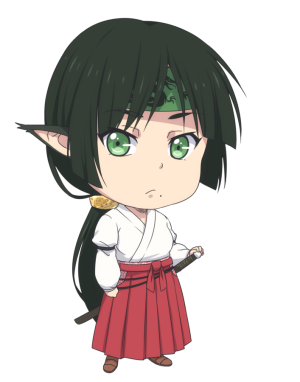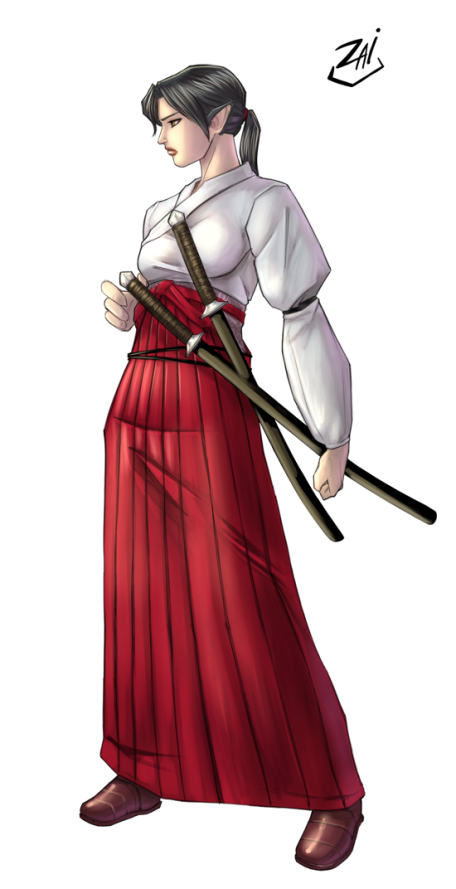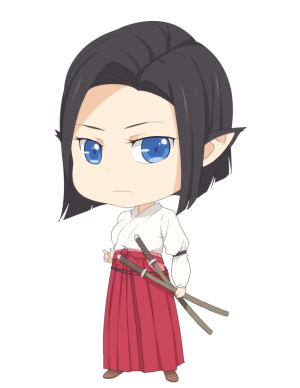Sidebar
Table of Contents
Ketsurui Samurai
A Ketsurui Samurai is one of the warriors that serve the Ketsurui Clan. The Ketsurui have maintained power as the ruling family of the Yamatai Star Empire for nearly the last three decades and are highly respected. Their warriors are highly able and trained in both melee and ranged combat and follow strict standards of dress, appearance, and etiquette. Ketsurui Samurai are born into their profession but are not required to stay in it. Each new-born samurai takes an oath to defend and die for the Ketsurui clan after their one-year of initial training. Prior to YE 40, all Ketsurui Samurai were considered officers and were able to command Star Army personnel if need be.
As of YE 40 - after the events of the Shadow Viper Rebellion (during which a group of rogue samurai attempted to kill the Empress of Yamatai) in YE 38 and the resulting loss of both their trust and prestige - the Samurai have effectively become an entity completely separate from the Star Army of Yamatai. They have become a private security force - essentially composed of civilians - for the Ketsurui Clan only. Those still within the Samurai were given options of how they wished to move forward. Many retired, some of the Samurai opted for ritual suicide, and many others remained either within the Samurai House as the security force for the Ketsurui Clan or went and enlisted within the Star Army of Yamatai as full-fledged members that were allowed to keep their current ranking. Any Samurai that opted to join after YE 40 were stripped of their rank and moved back to Santô Hei per the orders of Chujo Ketsurui-Chinomai Minori. Any Samurai that stayed as employees of either the Ketsurui Clan or Star Army of Yamatai were allowed to keep their NH-33 (Eihei) bodies; those that didn't however, were forced to relinquish their bodies and transfer into other bodies offered by Yamatai to its citizens.
Distinguishing Characteristics
Ketsurui Samurai are very standardized. One can expect a samurai to be a NH-33 (Eihei) Nekovalkyrja with pale skin, long black hair, Japanese facial features, a short white yukata, red hakama, all very well-kept and crisp, a katana, and a black Nekovalkyrja Service Pistol, Type 27. All Ketsurui Samurai are also trained in the use of Mindy M2 Power Armor. The samurai are not allowed to leave the palace without wearing their uniform. Some of their customs include never eating in public, never showing affection in public, maintaining a high standard of language in speech, and never putting their sword back into their sheaths without drawing blood.
Notable IC Warriors, Past and Present
The following is a list of notable Samurai characters present within the setting.
Ranks
Ketsurui Samurai have four “ranks” — Trainee, Journeywoman, Samurai, and Daimyo.
- Trainees only wear white. When at Samurai House, they often times wear gi. On formal occasions, they don white hakama, yukata, and obi. They are unarmed. The training lasts for one year. Their Star Army-equivalent rank was Nitô Hei; currently, however, all new Samurai enlisting in the Star Army hold the rank of Santô Hei.
- Journeywomen wear traditionally royal blue hakama and white yukata. They are considered full Samurai to outsiders, but within the Ketsurui Clan, they have entered their “formative years,” a kind of probationary period. They take assignments, sometimes alone, other times with a partner, a Samurai or both. The colors of their obi will vary, depending on what budō they obtain. They sometimes are armed. Their Star Army-equivalent rank was Nitô Heisho; currently, however, all new in the Star Army Samurai enlisting hold the rank of Santô Hei.
- Samurai wear red hakama and white yukata. They are full Samurai, free to take assignments (usually based on class) of their choosing and represent the House's interests if asked to do so. They always are armed with at least a blade (usually a katana), though the types of blades and their numbers will vary, depending on a Samurai's chosen budô. Their Star Army-equivalent rank was Santô Juni; currently, however, all new Samurai enlisting in the Star Army hold the rank of Santô Hei.
- Daimyo wear red hakama and yukata. There only is one at any given time, as she is the Samurai's leader. She ultimately speaks for the clan. In days past, she rarely left Samurai House, but with the onset of the First and Second Mishhuvurthyar Wars and the formation of a Samurai detachment in the First Fleet, the leader often is away, leaving day-to-day matters behind to a council of five elders. The Daimyo's Star Army-equivalent rank was Taisa; currently, however, all new Samurai enlisting in the Star Army hold the rank of Santô Hei.
Classes
Samurai have various classes that provide added authority to their ranks. The value of various classes depends on what the Daimyo or council consider a class to be worth. Common classes include:
- Sensei-no-budô: The most valued class, these are teachers of a martial form within the Ketsurui Clan. There is no value given to the form itself. This is a class reached after time in another class. It sometimes supersedes the previous class or compliments it. Example: Kôsuka
- Eihei-no-insen: Formerly a highly valued class, Stealth Sentinels invisibly and silently protected high-profile members of the Ketsurui and Kessaku clans, sometimes along Kessaku warriors (shinobi or samurai). They were invisible warriors with transparent swords, never far from their protection detail. Stealth Sentinels were known to spend weeks at a time without leaving stealth. Since the Shadow Viper betrayal in YE 38, the class has seen its prestige plummet. Example: Kei
- Eihei: A low-value but highly transitional class, Sentinels visibly protect the Empire's physical treasures, including Imperial buildings, memorials, and other property. Samurai do not remain in this class for too long, as it is used to give recently promoted journeywomen time to season before they are moved to another class.
- Yojimbo: A medium-high value class, these are Samurai who are committed to the protection of a certain member of the clan. Unlike eihei-no-insen, who are part of an elite force and are assigned certain protection details, yojimbo serve their charge and no one else. Examples: Masami, Hasegawa Sumaru, and Rei
- Power Armor Pilot: A low-value class, it is seen as a refuge for Samurai who do not excel at empty hands or melee combat. They are important, however, because they often times are the only direct contact with a Samurai enlisted Star Army personnel ever experience. Though commonly in uprated M2 Mindy armors, some who excel in the class are granted M7 Sarahs.
- Arahoshi: A medium-value class, Monks travel within the Empire, acting as spiritual guides, arbiters of justice or some other form of community assistance. Some of their duties overlap with other classes, but while an arahoshi's official authority is minimal, their influence can be far greater. Monks tend to settle within a community for some time, once they believe they have found their place.
- Gunsotsu: A low-medium-value class and the choice of the most bloodthirsty. Soldiers are formed into ground detachments and loaned to Star Army commanders. They are among the most special forces a Star Army commander can field in terrain-based combat. They are fierce, blisteringly powerful warriors who know just how to dispatch an opponent with modern weapons or their body's natural abilities. Example: Tomoe

- Karibito-no-akuma: A medium-value class. Demon hunters are the professional killers of the clan; they are dispatched as a secret force to eliminate enemies of the Empire. Formerly, they pursued enemies of the Ketsurui Clan with the intent of capturing them so they could be brought before the clan's rulers. Example: Chi
- Fukei: A medium-high-value class. Marshals historically were clan police, but they now act as the Imperial police force, possessing interplanetary jurisdiction with the ability to trump local and planetary law enforcement in the interest of the Empire. They often work with those agencies, however, in the pursuit of justice. Examples: Tokuko and Kei
- Ronin: A low-value but recent class, Wavewomen are the true Samurai wanderers. They are not failures — many are highly skilled Samurai of some age. They are warriors who have chosen to be adrift of formal duties for some time, as a kind of semi-retirement or for some other reason. Only with the abatement of the recent wars have ronin grown into a formal class, but they remain rare.
Prayer of the Ketsurui Samurai
| “On ships of strength and precious beauty, A warrior goes to do her duty, With strength, wisdom, and loyalty, And the spirit of certain victory…We thank our masters, the Ketsurui Clan, for this meal we are about to receive and the life we have that lets us do so; for it is this great clan whose noble leadership ensures not only the survival of the empire, but its purity and goodness as well. Let the Ketsurui fight against evil as vigilantly as we fight to protect the Ketsurui, and may their spirits watch over us as we watch over the living.” |
Traditions
| The samurai ate quietly, so long as no one was watching them. If any eyes in the room were looking towards them, they would stop and wait for the person to look another direction. Apparently, it was part of their etiquette not to be seen eating in front of others. |
Necessary Skills
The following is a list of skills known to all Ketsurui Samurai.
Communications
A Ketsurui Samurai is familiar with radio operation and procedures and can make transmissions to and receive transmissions from other characters through telepathy, starships, and power armor, under any conditions. A Ketsurui Samurai is fluent in both Trade (language) and Yamataigo (邪馬台語), and is skilled at producing calligraphy in both languages.
Fighting
All Ketsurui Samurai are masters of melee combat. Each is skilled and experienced in combat both in Yamatai-like conditions and in zero-gravity, with and without weapons. Weapons she is expert in include energy pistols, swords, spears, staves, knives, and power armor. Ketsurui Samurai are also trained with grenades, rifles, machine-guns, and a variety of randomized exotic weaponry.
Information Technology
A Ketsurui Samurai is capable of operating any computer system that uses the Kessaku OS, found on all Star Army starships. She is proficient in entering and/or searching for information.
Knowledge
All Ketsurui Samurai are familiar with the laws of the Yamatai Star Empire.
Mathematics
A Ketsurui Samurai receives basic mathematics training up to algebra and trigonometry.
OOC Notes
Sageshooter updated this article after receiving approval from Frostjaeger (using the checklist) on 2018/10/04 12:25.
Updated as asked by Ametheliana to include the events of the Shadow Viper Rebellion and the recent orders set forth by SACN. Edits made in light of the threads both here and here.
Page Tools
Terms of Service - Privacy Policy



